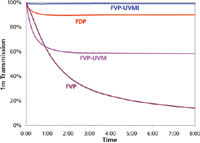Selection of Optical Fiber for Chromatographic Detectors and Remote Sensing Applications
The Application Notebook
Optical fibers are routinely used in liquid chromatographic detectors as a means of simplifying optical designs. Selection of the appropriate fiber is an important factor in achieving optimal system performance.
Optical fibers are routinely used in liquid chromatographic detectors as a means of simplifying optical designs. Selection of the appropriate fiber is an important factor in achieving optimal system performance.
Optical fiber has been used for many years in chromatographic applications which employ UV-Vis spectroscopy for sample detection. Fiber has allowed advances such as remote sensing, where in the "detection cell" no longer has to reside inside the detector itself, with dissolution sampling probes being a prime example. Important factors to consider when selecting a fiber are core size, –OH content, cladding thickness, potential bending radius, and optical attenuation. Of special interest is the phenomenon of UV solarization, which occurs when the fiber absorbs high intensity radiation below 240 nm and bonds within the glass structure are broken. The resulting "color centers" can exhibit strong absorbance which results in a marked increase in attenuation of the fiber (1). Alternately, many researchers would prefer to describe this as a decrease in light transmission.
Optical Fiber Attenuation in Deep UV
There are three key performance attributes to consider when comparing optical fiber types for use in the deep UV: 1) The initial attenuation of the fiber prior to significant exposure to UV radiation; 2) The additional attenuation that appears with exposure to UV radiation (eventually saturating or stabilizing); and 3) The stability of the attenuation during periods of nonexposure (commonly called "recovery"). The amount of recovery and redamage that takes place in repeated on/off cycles is generally a small fraction of the original degradation.
Fiber Types Available
As most chromatographic analysis is done in the UV-Vis spectral range, designers typically use a high –OH fiber. There are four fiber options:
- FVP is the traditional high –OH fiber series and is excellent for applications at or above 240 nm. Additional attenuation is significant at lower wavelengths due to rapid solarization.
- FVP-UVM offers moderate solarization resistance below 240 nm. Even though it experiences solarization damage during initial exposure, additional attenuation is minimal providing stable performance thereafter.
- FVP-UVMI is a hydrogen loaded fiber series. It provides outstanding solarization resistance to below 200 nm, but performance decreases dramatically once the hydrogen diffuses out of the fiber. Lifetime is dependent upon hydrogen content and therefore both the fiber diameter and operating temperature should be considered (2). This fiber type is thus limited to larger diameter fiber (i.e., 400 µm core or larger). Note that once the hydrogen diffuses out it behaves like FVP-UVM fiber.
- FDP fiber utilizes proprietary materials and processing steps, providing excellent solarization resistance without the concerns related to hydrogen diffusion. It has excellent lifetime and superior long term stability with only minimal damage. It is the fiber of choice for most deep UV applications, especially when smaller diameter fiber is required.
Fiber Comparison
Figure 1 contains a comparison of 214 nm transmission (relative to the initial) for various fiber types when exposed to Deuterium lamp radiation. The degradation can be seen, in most cases, to stabilize at a level beyond which no further damage occurs. Additional data on longer term exposure, and stability in on/off cycles has also been collected.

Figure 1: Effect of UV radiation on 214 nm transmission.
Conclusion
This note discusses solarization of optical fiber and provides recommendations for selecting the most appropriate fiber type for UV-Vis applications.
References
(1) J. Zhou, J. Shannon, and J. Clarkin, Biophotonic Int., 42–44 (Jan 2008).
(2) K.-F. Klein, R. Kaminski, S. Hüttel, J. Kirchhof, S. Grimm, and G. Nelson, SPIE-Proc. Vol. 3262C (BiOS 98), 150–160 (1998).
Polymicro Technologies, A subsidiary of Molex Incorporated
18019 North 25th Avenue, Phoenix, AZ 85023
tel. (602) 375-4100, fax (602) 375-4110
Website: www.polymicro.com

New Method Explored for the Detection of CECs in Crops Irrigated with Contaminated Water
April 30th 2025This new study presents a validated QuEChERS–LC-MS/MS method for detecting eight persistent, mobile, and toxic substances in escarole, tomatoes, and tomato leaves irrigated with contaminated water.

.png&w=3840&q=75)

.png&w=3840&q=75)



.png&w=3840&q=75)



.png&w=3840&q=75)


















